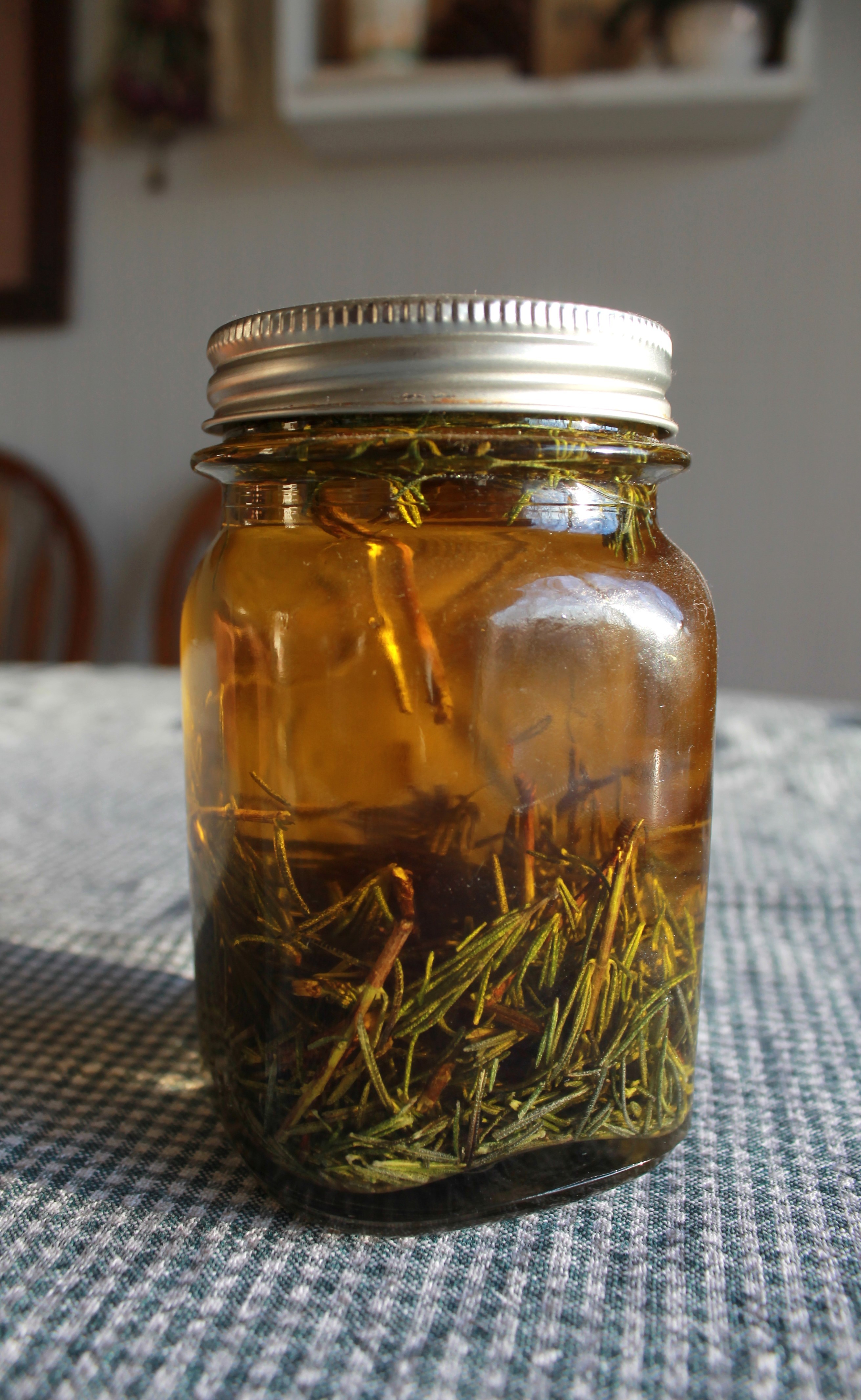Rosemary oil is a fantastic addition to any kitchen, offering a simple yet effective way to elevate your everyday cooking. Infusing olive oil with dried rosemary creates a flavorful oil that can transform ordinary dishes into culinary delights. Whether you’re using homegrown rosemary or store-bought herbs, making rosemary oil at home is an incredibly easy process.
This guide will walk you through a straightforward rosemary oil recipe perfect for cooking. We’ll also cover essential tips for choosing high-quality olive oil, discuss cold-hardy rosemary varieties for home gardeners, and explore various ways to use your homemade rosemary oil.
Let’s get started and dive into the world of homemade herb-infused oils!
Rosemary Oil Recipe for Cooking
When it comes to making herb-infused oils, using dried herbs is crucial. Fresh herbs contain water, which can lead to rancidity and bacterial growth in your oil. For a safe and long-lasting rosemary oil, always opt for dried rosemary.
It’s also important to consider the base oil. Extra Virgin Olive Oil (EVOO) is a popular and healthy choice, but be aware of the olive oil market. It’s been reported that a significant percentage of EVOO on the market is not authentic. To ensure quality, look for olive oils that specify a single farm origin and avoid blended oils. Some brands even offer traceability back to the harvest. While organic isn’t essential, good quality EVOO is a worthwhile investment for both flavor and health. Alternatively, non-GMO avocado oil can be used as a substitute.
For this recipe, we will use dried rosemary and extra virgin olive oil to create a flavorful and aromatic rosemary oil.
Tools You’ll Need:
- Air drying rack or dehydrator (for drying fresh rosemary, if needed)
- Pint-sized mason jar
- Olive oil dispenser (for storage)
Ingredients:
Yields 1 Pint Jar
- 1/2 cup dried rosemary
- 1.5 cups good quality extra virgin olive oil, or non-GMO avocado oil (adjust to fill jar)
Instructions:
- Dry the Rosemary: If you are using fresh rosemary, it needs to be completely dehydrated. You can air dry rosemary by hanging bundles upside down, spreading them on a cookie sheet, or using a dehydrator. The rosemary is ready when the leaves are brittle and easily crumble.
- Prepare the Rosemary: Once dried, chop the rosemary into smaller pieces. This helps to increase the surface area and allows for better flavor infusion into the oil.
- Combine Rosemary and Oil: Pour the chopped dried rosemary into the pint-sized mason jar. Cover the rosemary completely with your chosen oil, filling the jar to the top. Ensuring the jar is full helps to minimize oxidation and maintain the oil’s quality and color.
- Infuse the Oil: Seal the jar and place it in a dark, room temperature location, such as a cupboard, for 4 to 6 weeks. This infusion period allows the rosemary flavor to fully develop in the oil.
- Strain the Oil (Optional): After 4-6 weeks, you can strain the oil to remove the rosemary pieces. This step is optional; some people prefer to leave the rosemary in for continued flavor infusion and visual appeal. If you strain, use a cheesecloth or fine-mesh sieve.
- Store and Enjoy: Transfer the rosemary oil to a dark-colored olive oil dispenser or jar for optimal storage. Store it on your countertop away from direct sunlight for easy access. Properly made rosemary oil can last for several weeks to months at room temperature. A rancid odor will indicate spoilage.
Culinary Uses of Rosemary Oil
Rosemary oil is incredibly versatile in the kitchen. Think of it as a flavor upgrade to your regular olive oil. Anywhere you would typically use olive oil, consider using rosemary oil instead for an added layer of herbaceous flavor.
Here are some delicious ways to incorporate rosemary oil into your cooking:
- Marinades: Rosemary oil makes an excellent base for marinades, especially for meats like chicken and pork. Its robust flavor penetrates the food, adding depth and aroma.
- Salad Dressings: Whisk rosemary oil into vinaigrettes for salads. It pairs beautifully with balsamic vinegar or lemon juice, enhancing simple greens or more complex salads.
- Soup Toppings: Drizzle rosemary oil over soups just before serving. It adds a fragrant finishing touch to creamy tomato soup, hearty vegetable soups, or even bean-based soups.
- Roasted Vegetables: Toss vegetables like potatoes, carrots, Brussels sprouts, or bell peppers with rosemary oil before roasting. The heat intensifies the rosemary flavor, creating savory and aromatic roasted veggies.
- Bread Dipping: Serve rosemary oil with crusty bread for a simple yet flavorful appetizer. Add a pinch of salt and pepper to the oil for extra seasoning.
- Flavoring Protein: Use rosemary oil to sauté or roast chicken, pork, or lamb. It complements these meats exceptionally well, infusing them with a delightful herbal note.
Don’t hesitate to experiment with rosemary oil in your favorite recipes. Its distinctive flavor profile can enhance a wide range of dishes, making it a valuable pantry staple.
Growing Rosemary at Home
One of the joys of making rosemary oil is using homegrown rosemary. You don’t need a large garden to cultivate this fragrant herb. Rosemary is well-suited for container gardening and can thrive even in small spaces, making it accessible to almost everyone.
Rosemary plants are perennials, meaning they come back year after year. Certain varieties are particularly cold-hardy, making them suitable for a wider range of climates. They prefer sunny locations with well-draining soil, even sandy soil. Once established, rosemary plants are relatively low-maintenance, requiring minimal care.
You can harvest rosemary throughout the summer months, ensuring a fresh supply for your culinary needs.
If you’re interested in growing specific types of rosemary, consider these varieties known for their flavor and hardiness:
- French Rosemary: Known for its strong fragrance and flavor.
- Primed Rosemary: A compact variety, good for containers.
- Alcalde Rosemary: Upright growth habit and good flavor.
- Madeline Hill Rosemary: Cold-hardy and flavorful.
While specific rosemary varieties can sometimes be harder to find, a little research at local nurseries or online seed suppliers can yield rewarding results. Often, rosemary is simply labeled as “rosemary,” and any garden variety will work well for making oil.
FAQs About Rosemary Oil
What are the benefits of rosemary oil?
Rosemary oil offers a range of benefits, both internally and externally. Externally, it is known to help with hair loss and soothe arthritic pain. Internally, rosemary is rich in antioxidants and antimicrobial compounds. Research is even exploring its potential for tumor suppression due to its Rosmarinic Acid content. Furthermore, using olive oil as a base adds its own health benefits, including healthy fats, anti-inflammatory properties, and antioxidants. The combination creates a powerhouse oil with multiple advantages.
Is rosemary oil safe to ingest?
Yes, rosemary oil made with edible oils like olive or avocado oil is safe to ingest in culinary amounts. Use it as you would regular cooking oil in your daily meals.
Can I use any type of rosemary for making oil?
Yes, any garden variety of rosemary is suitable for making rosemary oil. Different rosemary types have evolved to adapt to various climates, but they all share similar culinary benefits and flavor profiles when used in cooking.
Final Thoughts
Infusing oils with herbs is a kitchen practice I wholeheartedly embrace. In fact, most of the olive oil I purchase ends up transformed into herb-infused oils, adding depth and character to my cooking.
When making rosemary oil, or any herb-infused oil, remember the importance of using dried herbs and good quality oil. Paying attention to the quality of your ingredients is key to achieving the best flavor and ensuring a safe and delicious final product.
Enjoy the process of making your own rosemary oil and the delightful culinary possibilities it unlocks!
-Chelsea, The Cottage Vegetable
The Cottage Vegetable
Gardening & Preserving for a Practical Kitchen

